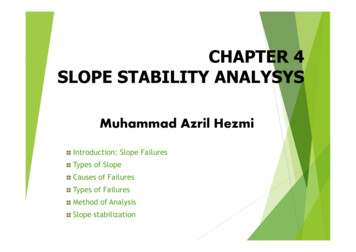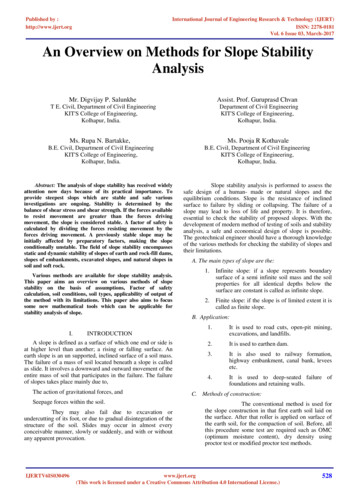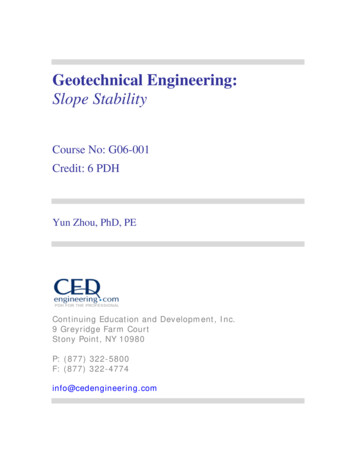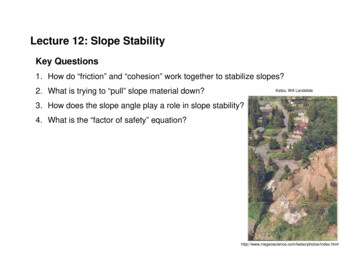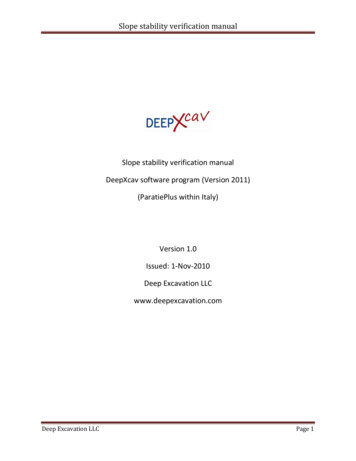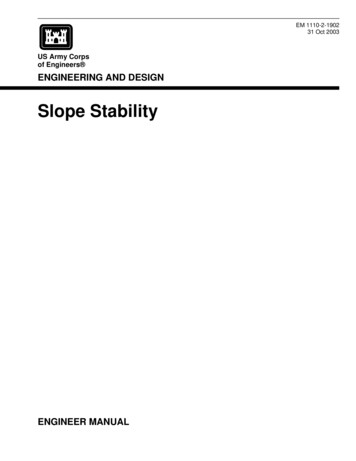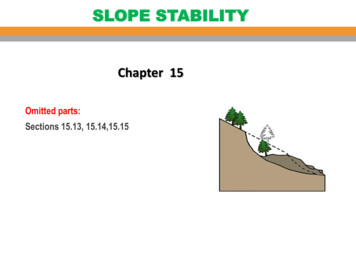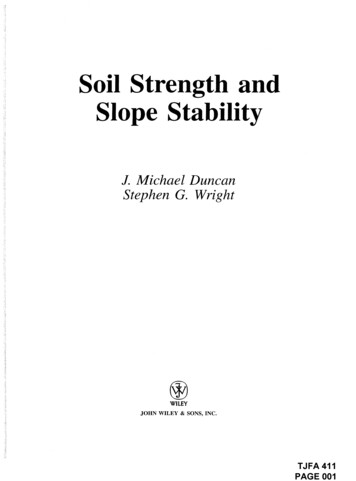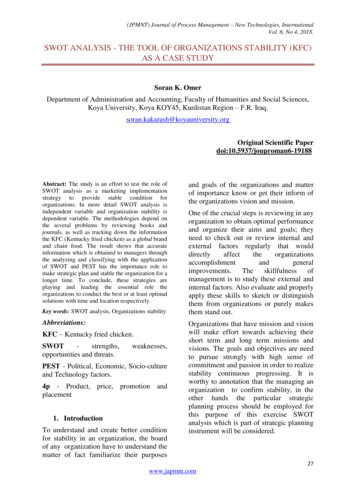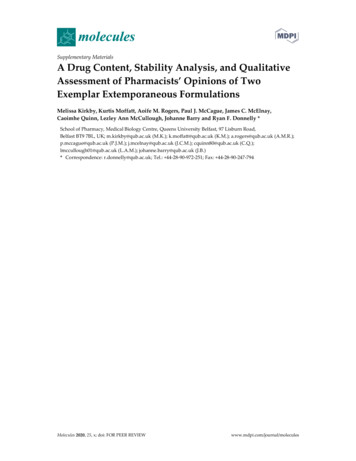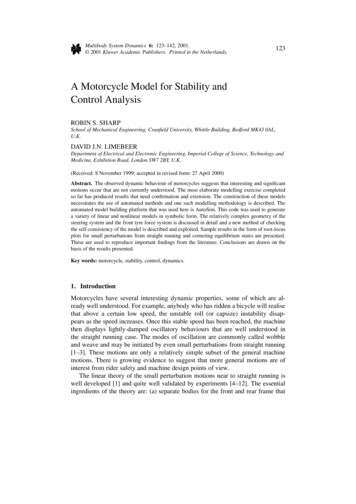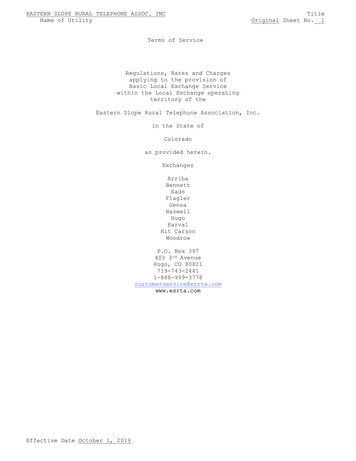
Transcription
Chapter 77 .1Slope Stability AnalysisOverviewSlope stability analysis is used in a wide variety of geotechnical engineering problems,including, but not limited to, the following: Determination of stable cut and fill slopes Assessment of overall stability of retaining walls, including global and compoundstability (includes permanent systems and temporary shoring systems) Assessment of overall stability of shallow and deep foundations for structureslocated on slopes or over potentially unstable soils, including the determinationof lateral forces applied to foundations and walls due to potentially unstable slopes Stability assessment of landslides (mechanisms of failure, and determinationof design properties through back-analysis), and design of mitigation techniquesto improve stability Evaluation of instability due to liquefactionTypes of slope stability analyses include rotational slope failure, translational failure,irregular surfaces of sliding, and infinite slope failure. Stability analysis techniquesspecific to rock slopes, other than highly fractured rock masses that can in effect betreated as soil, are described in Chapter 12. Detailed stability assessment of landslidesis described in Chapter 13.7 .2 Development of Design Parameters and Other Input Data for SlopeStability AnalysisThe input data needed for slope stability analysis is described in Chapter 2 for siteinvestigation considerations, Chapters 9 and 10 for fills and cuts, and Chapter 13 forlandslides. Chapter 5 provides requirements for the assessment of design propertyinput parameters.Detailed assessment of soil and rock stratigraphy is critical to the proper assessmentof slope stability, and is in itself a direct input parameter for slope stability analysis.It is important to define any thin weak layers present, the presence of slickensides,etc., as these fine details of the stratigraphy could control the stability of the slopein question. Knowledge of the geologic nature of the strata present at the siteand knowledge of past performance of such strata may also be critical factors inthe assessment of slope stability. See Chapter 5 for additional requirements anddiscussion regarding the determination and characterization of geologic strata and thedetermination of ESU’s for design purposes.Whether long-term or short-term stability is in view, and which will control thestability of the slope, will affect the selection of soil and rock shear strength parametersused as input in the analysis. For short-term stability analysis, undrained shear strengthparameters should be obtained. For long-term stability analysis, drained shear strengthparameters should be obtained. For assessing the stability of landslides, residual shearstrength parameters will be needed, since the soil has in such has typically deformedWSDOT Geotechnical Design ManualOctober 2013M 46-03.08Page 7-1
Slope Stability AnalysisChapter 7enough to reach a residual value. For highly overconsolidated clays, such as theSeattle clays (e.g., Lawton Formation), if the slope is relatively free to deform afterthe cut is made or is otherwise unloaded, even if a structure such as a wall is placedto retain the slope after that deformation has already occurred, residual shear strengthparameters should be obtained and used for the stability analysis. See Chapter 5 forrequirements on the development of shear strength parameters.Detailed assessment of the groundwater regime within and beneath the slope/landslidemass is also critical. Detailed pieziometric data at multiple locations and depths withinand below the slope will likely be needed, depending on the geologic complexityof the stratigraphy and groundwater conditions. Potential seepage at the face of theslope must be assessed and addressed. In some cases, detailed flow net analysismay be needed. If seepage does exit at the slope face, the potential for soil pipingshould also be assessed as a slope stability failure mechanism, especially in highlyerodable silts and sands. If groundwater varies seasonally, long-term monitoringof the groundwater levels in the soil should be conducted. If groundwater levels tendto be responsive to significant rainfall events, the long-term groundwater monitoringshould be continuous, and on-site rainfall data collection should also be considered.7 .3Design RequirementsLimit equilibrium methods shall be used to assess slope stability. The ModifiedBishop, simplified Janbu, Spencer, or other widely accepted slope stability analysismethods should be used for rotational, translational and irregular surface failuremechanisms. Each limit equilibrium method varies with regard to assumptions usedand how stability is determined. Therefore, a minimum of two limit equilibriummethods should be used and compared to one another to ensure that the the levelof safety in the slope is accurately assessed. In cases where the stability failuremechanisms anticipated are not well modeled by limit equilibrium techniques,or if deformation analysis of the slope is required, more sophisticated analysistechniques (e.g., finite difference methods such as is used by the computer programFLAC) may be used in addition to the limit equilibrium methodologies. Since thesemore sophisticated methods are quite sensitive to the quality of the input data andthe details of the model setup, including the selection of constitutive models usedto represent the material properties and behavior, limit equilibrium methods shouldalso be used in such cases, and input parameters should be measured or assessedfrom back-analysis techniques whenever possible. If the differences in the results aresignificant, the reasons for the differences shall be assessed with consideration to anyavailable field observations to assess the correctness of the design model used. If thereasons for the differences cannot be assessed, and if the FLAC model provides a lessconservative result than the limit equilibrium based methods, the limit equilibriumbased methods shall govern the design.If the potential slope failure mechanism is anticipated to be relatively shallow andparallel to the slope face, with or without seepage affects, an infinite slope analysisshould be conducted. Typically, slope heights of 15 to 20 feet or more are requiredto have this type of failure mechanism. For infinite slopes consisting of cohesionlesssoils that are either above the water table or that are fully submerged, the factorof safety for slope stability is determined as follows:Page 7-2WSDOT Geotechnical Design Manual M 46-03.08October 2013
FSFS TanTan (7-1)(7-1)Chapter 7Slope Stability Analysiswhere,where,TanTan FSFS TanφTanβTan internalTanφφ thethesoilsoil(7-1)Where:ββ orizontal relative angle TanTan φFSFS bb the angle of internal friction for the soil ss TanTan slope etermineddeterminedasfollows:asfollows:Forinfinite slopes that have seepage at the slope face, the factor of safety for slopestability is determined as follows: TanTan FSFS γbbb TanφFS ss TanTanTanβ γs(7-2)(7-2)(7-2)Where:γb the buoyant unit weight of the soilγs the saturated unit weight of the soilwhere,where,γγbb soilsoilConsideringthatthebuoyantunitweight is roughly one-half of the saturated unitγγss ethesoilsoilweight, seepage on the slope face can reduce the factor of safety by a factor of two, aconditionwhichshould obviously be avoided through some typeof drainageif at ise much flatter slopes will be needed. When using the infinite slopeDecember20062006method, if the FS is near or below 1.0 to 1.15, severe erosion or shallow slumpingis likely. Vegetation on the slope can help to reduce this problem, as the vegetationroots add cohesion to the surficial soil, improving stability. Note that conductingan infinite slope analysis does not preclude the need to check for deeper slope failuremechanisms, such as would be assessed by the Modified Bishop or similar methodslisted above.Translational (block) or noncircular searches are generally more appropriate formodeling thin weak layers or suspected planes of weakness, and for modeling stabilityof long natural slopes or of geologic strata with pronounced shear strength anisotropy(e.g., due to layered/bedded macrostructure or pre-existing fracture patterns). If thereis a disparately strong unit either below or above a thin weak unit, the user must ensurethat the modeled failure plane lies within the suspected weak unit so that the mostcritical failure surface is modeled as accurately as possible. Circular searches for thesetypes of conditions should generally be avoided as they do not generally model themost critical failure surface.For very simplified cases, design charts to assess slope stability are available.Examples of simplified design charts are provided in NAVFAC DM-7 (US Departmentof Defense, 2005). These charts are for a c-φ soil, and apply only to relatively uniformsoil conditions within and below the cut slope. They do not apply to fills over relativelysoft ground, as well as to cuts in primarily cohesive soils. Since these charts are for ac-φ soil, a small cohesion will be needed to perform the calculation. If these charts areto be used, it is recommended that a cohesion of 50 to 100 psf be used in combinationwith the soil friction angle obtained from SPT correlation for relatively clean sandsand gravels. For silty to very silty sands and gravels, the cohesion could be increasedto 100 to 200 psf, but with the friction angle from SPT correlation (see Chapter 5)reduced by 2 to 3 degrees, if it is not feasible to obtain undisturbed soil samplessuitable for laboratory testing to measure the soil shear strength directly. This shouldbe considered general guidance, and good engineering judgment should be appliedwhen selecting soil parameters for this type of an analysis. Simplified design chartsshall only be used for final design of non-critical slopes that are approximately 10 feetWSDOT Geotechnical Design ManualOctober 2013M 46-03.08Page 7-3
Slope Stability AnalysisChapter 7in height or less and that are consistent with the simplified assumptions used by thedesign chart. Simplified design charts may be used as applicable for larger slopes forpreliminary design.The detailed guidance for slope stability analysis provided by Abramson, et al. (1996)should be used.For additional design requirements for temporary slopes, including application of theapplicable WAC’s, see Sections 15.7 and 9.5.5.7 .4Resistance Factors and Safety Factors for Slope Stability AnalysisFor overall stability analysis of walls and structure foundations, design shall beconsistent with Chapters 6, 8 and 15 and the AASHTO LRFD Bridge DesignSpecifications. For slopes adjacent to but not directly supporting structures, amaximum resistance factor of 0.75 should be used. For foundations on slopes thatsupport structures such as bridges and retaining walls, a maximum resistance factorof 0.65 should be used. This reduced resistance factor also applies if the slope is notdirectly supporting the structure, but if slope failure occurred, it could impact anddamage the structure. Exceptions to this could include minor walls that have a minimalimpact on the stability of the existing slope, in which the 0.75 resistance factor maybe used. Since these resistance factors are combined with a load factor of 1.0 (overallstability is assessed as a service limit state only), these resistance factors of 0.75 and0.65 are equivalent to a safety factor of 1.3 and 1.5, respectively.For general slope stability analysis of permanent cuts, fills, and landslide repairs, aminimum safety factor of 1.25 should be used. Larger safety factors should be usedif there is significant uncertainty in the analysis input parameters. The Monte Carlosimulation features now available in some slope stability computer programs may beused for this purpose, from which a probability of failure can be determined, provideda coefficient of variation for each of the input parameters can be ascertained. Forconsiderations regarding the statistical characterization of input parameters, see Allen,et al. (2005). For minimum safety factors and resistance factors for temporary cuts, seeSection 15.7.For seismic analysis, if seismic analysis is conducted (see Chapter 6 for policies onthis issue), a maximum resistance factor of 0.9 should be used for slopes involving oradjacent to walls and structure foundations. This is equivalent to a safety factor of 1.1.For other slopes (cuts, fills, and landslide repairs), a minimum safety factor of 1.05shall be used.Page 7-4WSDOT Geotechnical Design Manual M 46-03.08October 2013
Chapter 7Slope Stability AnalysisConditionsProbability of Failure, PfUnacceptable in most cases 0.1Temporary structures with no potential life loss and low repair costSlope of riverbank at docks, no alternative docks, pier shutdown threatensoperationsLow consequences of failure, repairs when time permits, repair cost less thancost to go to lower Pf0.10.01 to 0.020.01Existing large cut on interstate highway0.01 to 0.02New large cut (i.e., to be constructed) on interstate highway0.01 or lessAcceptable in most cases except if lives may be lost0.001Acceptable for all slopes0.0001Unnecessarily low0.00001Slope Stability – Probability of Failure (Adapted From Santamarina, et al ., 1992)Table 7-17 .5ReferencesAbramson, L., Boyce, G., Lee, T., and Sharma, S., 1996, Slope Stability
Chapter 7 Slope Stability Analysis 7 .1 Overview Slope stability analysis is used in a wide variety of geotechnical engineering problems, including, but not limited to, the following: Determination of stable cut and fill slopes Assessment of overall stability of retaining walls, including global and compound
